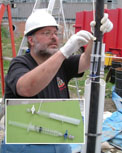Subsurface Point-Source Contamination
|
|
|
|
|

The syringes strapped to the sided of the packer pipe rod are for measuring concentrations of dissolved hydrogen gas. USGS scientists are testing two different syringe materials in order to determine which is best suited for long-term diffusion sampling in trichloroethylene-contaminated fractured rock aquifers -- from the Naval Air Warfare Center (NAWC) Research Site
|
|
|
The Toxics Program conducts intensive field investigations to study common classes of subsurface
point-source contamination. (more information)
Complete listing of point-source investigations and projects >>
Other Subsurface Point-Source Investigations
Subsurface Point-Source Contamination Information
Meetings and Conferences
- USGS and EPA cosponsor the USGS Toxic Substances Hydrology Program National Point Source Research Meeting, San Diego, Calif., January 26-29, 2009
- The USGS cosponsors the special session Hydrogeological Research Sites and Observatories at the 2008 AGU Fall Meeting, San Francisco, California, December 15-19, 2008
- USGS sponsors the special session In Situ Approaches for Measuring Biodegradation Potential and Rates in Subsurface Environments at the 2008 Joint Annual Meeting, Houston, Texas, October 5-9, 2008
- USGS and the University of Wisconsin-Madison are cosponsoring the joint session A Celebration of Soil Science, Solute Transport, and National-Scale Water-Quality Research: In Honor of Jacob Rubin at the 2008 Joint Annual Meeting, Houston, Texas, October 5-9, 2008
- USGS and EPA host the USGS/EPA Workshop on Transport and Remediation of Chlorinated Solvents in Fractured Sedimentary Rocks, West Trenton, New Jersey, September 25, 2008
New Publications
Upcoming Publications
- The effect of planting method on Populus Spp. and Salix Sp. mortality and growth at a petroleum-hydrocarbon contaminated shallow aquifer: Cook, R.L., Landmeyer, J.E., Atkinson, B., Messier, J.P., and Guthrie Nichols, E., International Journal of Phytoremediation (IN PRESS).
- Monitoring the removal of phosphate from ground water discharging through a pond-bottom permeable reactive: McCobb, T.D., LeBlanc, D.R., and Massey, A.J., Ground Water Monitoring and Remediation (IN PRESS).
- Soil-CO2 flux in an arid environment--A multiple year study: Riggs, A.C., Stannard, D.I., Maestas, F., Karlinger, M., and Striegl, R.G., U.S. Geological Survey Scientific Investigations Report (IN PRESS).
- The relative importance of abiotic and biotic transformation of carbon tetrachloride in anaerobic soils and sediments: Shao, H., and Butler, E.C., Soil and Sediment Contamination--An International Journal (IN PRESS).
- Use of inverse modeling methods to improve ground-water-modeling calibration and evaluate model-prediction uncertainty, Camp Edwards, Cape Cod, Massachusetts: Walter, D.A., and LeBlanc, D.R., U.S. Geological Survey Scientific Investigations Report 2007-5257 (IN PRESS).
- Transport of tritium contamination from the shallow unsaturated zone to the atmosphere in an arid environment: Garcia, C.A., Andraski, B.J., Stonestrom, D.A., Cooper, C.A., Johnson, M.J., Michel, R.L., and Wheatcraft, S.W., Vadose Zone Journal, v. 8, no. 2 (IN PRESS).
- Biological degradation of chloroethenes: Bradley, P.M., and Chapelle, F.H., in SERDP/ESTCP Monograph on Remediation of Dissolved-Phase Chlorinated Solvents: (IN PRESS).
New Publications
- Distinguishing iron-reducing from sulfate-reducing conditions: Chapelle, F.H., Bradley, P.M., Thomas, M.A., and McMahon, P.B., 2009, Ground Water, v. 47, no. 2, p. 300-305, doi:10.1111/j.1745-6584.2008.00536.x.
- Biogeochemistry at a wetland sediment-alluvial aquifer interface in a landfill leachate plume: Lorah, M.M., Cozzarelli, I.M., and Böhlke, J.K., 2009, Journal of Contaminant Hydrology, v. 105, no. 3-4, p. 99-117, doi:10.1016/j.jconhyd.2008.11.008.
- Case study of a full-scale evapotranspiration cover: McGuire, P.E., Andraski, B.J., and Archibald, R., 2009, Journal of Geotechnical and Geoenvironmental Engineering, v. 135, no. 3, p. 316-332, doi:10.1061/(ASCE)1090-0241(2009)135:3(316).
- Effects of simplifying fracture network representation on inert chemical migration in fracture-controlled aquifers: Wellman, T.P., Shapiro, A.M., and Hill, M.C., 2009, Water Resources Research, v. 45, no. 1, W01416, doi:10.1029/2008WR007025.
- Assessing recharge across the southwest: Stonestrom, D.A., 2009, Southwest Hydrology, v. 8, no. 1, p. 10-11.
- Waste-indicator and pharmaceutical compounds in landfill-leachate-affected ground water near Elkhart, Indiana, 2000-2002: Buszka, P.M., Yeskis, D.J., Kolpin, D.W., Furlong, E.T., Zaugg, S.D., and Meyer, M.T., 2009, Bulletin of Environmental Contamination and Toxicology, doi:10.1007/s00128-009-9702-z (Advanced Web release).
- Microbial characterization of nitrification in a shallow, nitrogen-contaminated aquifer, Cape Cod, Massachusetts and detection of a novel cluster associated with nitrifying Betaproteobacteria: Miller, D.N., and Smith, R.L., 2009, Journal of Contaminant Hydrology, v. 103, no. 3-4, p. 182-193, doi:10.1016/j.jconhyd.2008.10.011.
- Use of inverse modeling methods to improve ground-water-modeling calibration and evaluate model-prediction uncertainty, Camp Edwards, Cape Cod, Massachusetts: Walter, D.A., and LeBlanc, D.R., 2008, U.S. Geological Survey Scientific Investigations Report 2007-5257.
- Prevalence of tumors in brown bullhead from three lakes in southeastern Massachusetts, 2002: Baumann, P.C., LeBlanc, D.R., Blazer, V.S., Meier, J.R., Hurley, S.T., and Kiryu, Y., 2008, U.S. Geological Survey Scientific Investigations Report 2008-5198.
- Fate of consumer-product chemicals in the subsurface environment--25 years of research on Cape Cod, Massachusetts, USA: Barber, L.B., 2008, in Trefry, M.G., ed., Groundwater Quality 2007--Securing Groundwater Quality in Urban and Industrial Environments: International Association of Hydrological Sciences IAHS Redbook, IAHS Publ. 324, p. 126-132.
- Subsurface fate and transport of sulfamethoxazole, 4-nonylphenol, and 17Β-estradiol: Barber, L.B., Meyer, M.T., LeBlanc, D.R., Kolpin, D.W., Bradley, P.M., Chapelle, F.H., and Rubio, F., 2008, in Trefry, M.G., ed., Groundwater Quality 2007--Securing Groundwater Quality in Urban and Industrial Environments: International Association of Hydrological Sciences IAHS Redbook, IAHS Publ. 324, p. 133-139.
|

|